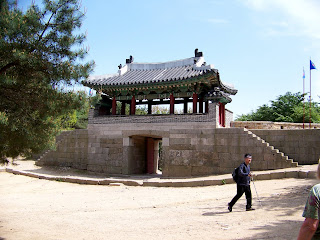Black Goat Food Village
Saturday afternoon Professor Kim, who teaches Chinese Literature, picked us up at our dorm to take us to a "garden restaurant" on Geumgang Mountain. In the sunlight his car reveals shades of deep purple like a concord grape.
We picked up his wife and three small sons at their apartment building and then headed out.
As he lives at the foot of Geumgang Mountain, we drove quickly out of the city proper, up into the mountain on a two lane switch-back road. No more than ten minutes later we reached a portion of the Geumjeongsanseong Fortress wall that is being rebuilt over the roadway to allow foot traffic on top of the wall and car traffic through it. The fortress itself dates back more than three hundred years, intended as protection again Japanese invasions.
Once through the gate we turned off the paved road. We drove along a wide hiking trail that was in places smooth and hard as if paved, in places rough with large irregular paving stones, and in places rutted and in need of repair. We bounced along to the delight of Kim's young boys, sharing the path with hikers and bicycles.
Ten minutes along this trail we pulled off at the garden restaurant. There were six or seven outlying huts and a kitchen building with a traditional tiled roof and walls made partly of wood and partly of cinder block.The huts have clear plastic walls, galvanized pipe supports, and canvas roofs like tents. Although they look temporary, they are clearly permanent; they are built on concrete slabs, with the pipe framework embedded in the concrete.
It reminded me of a restaurant our travel group visited in Russia in 2004 somewhere off the hi-way between Moscow and Vladimir, although the resemblance is mostly in the feel and look of the place rather than in the particulars.
As usual, we were the only non-Koreans in the area.
Professor Kim parked in a space between huts, near a large mound of discarded wood scraps and cinder blocks and just down from a vegetable garden. He had called ahead to order our meal and to tell them that Americans were coming. I am sure the "heads up" was appreciated. They were expecting us. The duck was being cooked.
We were greeted -- Ahn-yeong-ha-seo! -- and welcomed into one of the eating rooms in the kitchen building.
Many of the huts had groups or couples eating. There were, as well, several platforms out under the trees where people already eating and relaxing.
We enjoyed eating with Prof. Kim and his family. His two older boys were mostly out of the room, running around with young children from other huts. They entertained themselves finding worms and insects and watching water work its way down the drive.
Our room was covered -- ceiling, walls, and floor -- with linoleum. It was free of decoration and clutter. Apart from two extra tables folded against the wall, the room was devoted to eating -- one low table and cushions for sitting.
Our menu was duck and goat. I think Korean meals are identified by the meat dishes, since there are always many small side dishes that may present a variety of special foods but always include kimchi. To my memory I have not had duck since I was a boy and we once ate ducks my father had shot. If it were not for the unpleasant memory of helping to pluck the ducks, I would probably not remember eating duck at all.
And we have never had goat, to my knowledge. Both were good. Because the goat was spicy, I am not really sure that I can describe the taste except that it made my lips and tongue burn a little. We ate quite a lot.
And we have never had goat, to my knowledge. Both were good. Because the goat was spicy, I am not really sure that I can describe the taste except that it made my lips and tongue burn a little. We ate quite a lot.
At the end of our meal we were served rice soup made from the duck broth. By this time we could hear recorded music coming from one of the huts. Pop music alone at first and then singing. Professor Kim said that they were singing pop songs that people his age would recognize. A national pastime, this singing.
The voices we heard came from three older men who were belting out tunes in a hut by themselves, on a microphone, reading lyrics from a TV screen set up in the corner. A dozen or more empty green bottles lay about the floor.
After we had finished with the duck and goat and acorn moo, we walked with Professor Kim up to the restored West Gate of the Fortress Wall. The Fortess is a story in itself.
When our walk was finished, we drove the switchbacks back into what has become our city, feeling full and a bit sleepy. It was a good afternoon, thanks to Professor Kim and his sweet wife and his energetic boys.

Although we got near, we did not drive far enough into the mountain to reach the Black Goat Food Village. I thought I would use the name for my title as it has a certain exotic charm.











No comments:
Post a Comment